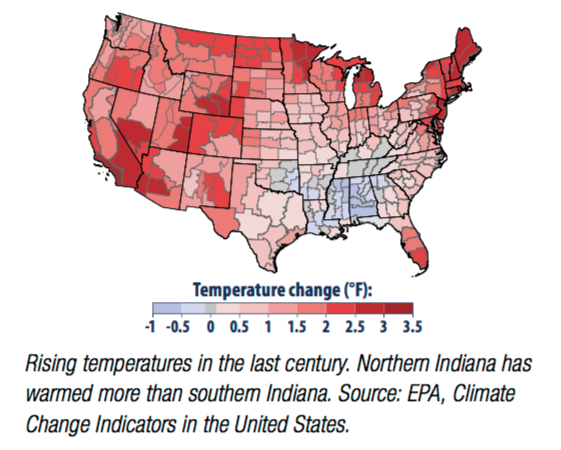August 25, 2016 – Fact Sheet from USEPA
Indiana’s climate is changing. Most of the state has warmed about one degree (F) in the last century. Floods are becoming more frequent, and ice cover on the Great Lakes is forming later or melting sooner. In the coming decades, the state will have more extremely hot days, which may harm public health in urban areas and corn harvests in rural areas.
Our climate is changing because the earth is warming. People have increased the amount of carbon dioxide in the air by 40 percent since the late 1700s. Other heat- trapping greenhouse gases are also increasing. These gases have warmed the surface and lower atmosphere of our planet about one degree during the last 50 years. Evaporation increases as the atmosphere warms, which increases humidity, average rainfall, and the frequency of heavy rainstorms in many places—but contributes to drought in others.
Greenhouse gases are also changing the world’s oceans and ice cover. Carbon dioxide reacts with water to
form carbonic acid, so the oceans are becoming more acidic. The surface of the ocean has also warmed about one degree during the last 80 years. Although warmer temperatures cause sea level to rise, the impact on water levels in the Great Lakes is not yet known. Warmer air also melts ice and snow earlier in spring.
Heavy Precipitation and Flooding
Changing the climate is likely to increase the frequency of floods in Indiana. Over the last half century, average annual precipitation in most of the Midwest has increased by 5 to 10 percent. But rainfall during the four wettest days of the year has increased about 35 percent, and the amount of water flowing in most streams during the worst flood of the year has increased by more than 20 percent. During the next century, spring rainfall and average precipitation are likely to increase, and severe rainstorms are likely to intensify. Each of these factors will tend to further increase the risk of flooding.
Ohio River
Flooding occasionally threatens both navigation and riverfront communities, and greater river flows could increase these threats. In 2011, a combination of heavy rainfall and melting snow caused flooding along the Ohio and Wabash rivers in Southern Indiana and closed the lower Ohio River to navigation.
Although springtime in Indiana is likely to be wetter, summer droughts are likely to be more severe. Higher evaporation and lower summer rainfall are likely to reduce river flows. The drought of 2005 caused portions of the lower Ohio River to be closed to commercial navigation, which delayed shipments of crops and other products to and from upstream states like Indiana. In 2012, a drought caused navigation restrictions on the lower Mississippi River, which cost the region more than $275 million.
One advantage of climate change is that warmer winters reduce the number of days that ice prevents navigation.
Great Lakes
The ice-free season along the Great Lakes is also becoming longer. Between 1994 and 2011, reduced ice cover lengthened the shipping season on the lakes by eight days. The Great Lakes are likely to warm another 3° to 7°F in the next 70 years, which will further extend the shipping season.
In Lake Michigan, the changing climate is likely to harm water quality. Warmer water tends to cause more algal blooms, which can be unsightly, harm fish, and degrade water quality. Severe storms also increase the amount of pollutants that run off from land to water, so the risk of algal blooms will be greater if storms become more severe. Increasingly severe rainstorms could also cause sewers to overflow into the lake more often, threatening beach safety and drinking water supplies.
Agriculture
Changing the climate will have both beneficial and harmful effects on farming. Longer frost-free growing seasons and higher concentrations of atmospheric carbon dioxide would increase yields for some crops during an average year. But increasingly hot summers are likely to reduce yields of corn and possibly soybeans. Seventy years from now, much of Indiana is likely to have 5 to 15 more days per year with temperatures above 95°F than it has today. More severe droughts or floods would also hurt crop yields.
Air Pollution and Human Health
Rising temperatures can harm air quality and amplify existing threats to human health. Warmer weather can increase the production of ground-level ozone, a pollutant that causes lung and heart problems. Ozone also harms plants. In rural Indiana, ozone levels are high enough to signi cantly reduce yields of soybeans and winter wheat. EPA and the Indiana Department of Environmental Management have been working to reduce ozone concentrations. As the climate changes, continued progress toward clean air will become more dif cult.
Hot days can be unhealthy—even dangerous. High air tem- peratures can cause heat stroke and dehydration, and affect people’s cardiovascular and nervous systems. Midwestern cities like Indianapolis are vulnerable to heat waves, because many houses and apartments lack air conditioning, and urban areas are typically warmer than their rural surroundings. In recent decades, severe heat waves have killed hundreds of people across the Midwest. Heat stress is expected to increase as climate change brings hotter summer temperatures and more humidity. Certain people are especially vulnerable, including children, the elderly, the sick, and the poor.

